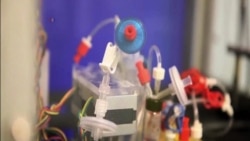Testing new drugs on lab animals is not the same as testing them on the species they are intended for. But in early stages of research, testing on humans is sometimes nearly impossible. Scientists are now trying to develop human micro-organs they say may greatly advance development of new medicines.
Testing new drugs on lab animals, such as mice or rats, is not ideal because, when tested on humans, many promising drugs fail due to adverse effects on other organs.
Researchers at Vanderbilt University Medical Center, in Nashville, Tennessee, are now developing miniaturized living copies of certain human organs they say will greatly improve testing the effectiveness of drugs and chemicals on people.
This small bioreactor, containing just a handful of cells taken from a human liver, also contains sensors that monitor the micro-organ’s health.
John Wikswo is a Professor of Biomedical Science and Physics at Vanderbilt.
“The trick is to make it not too simple but simple enough and then ask it the questions that are most important," said Wikswo.
The ultimate goal is to connect several micro-organs, such as liver, heart, lungs and kidney, for testing the effects of a drug targeted at just one of them.
Wikswo says another goal is to design something affordable and accessible to researchers everywhere.
“You got to keep the cost low, so someone can have hundreds or thousands of these running in their lab," he said.
Researcher John McLean says this method could one day be used for designing personalized drugs based, for example, on the specific chemical make-up of a tumor.
“So what you would do is look at how those particular cells in that tumor respond to different parts of chemotherapy, such that what you could do is call the physician the next day and say use drug number seven," said McLean.
Scientists expect that, within two years, they will have several interconnected human micro-organs ready for testing new medicines.
Testing new drugs on lab animals, such as mice or rats, is not ideal because, when tested on humans, many promising drugs fail due to adverse effects on other organs.
Researchers at Vanderbilt University Medical Center, in Nashville, Tennessee, are now developing miniaturized living copies of certain human organs they say will greatly improve testing the effectiveness of drugs and chemicals on people.
This small bioreactor, containing just a handful of cells taken from a human liver, also contains sensors that monitor the micro-organ’s health.
John Wikswo is a Professor of Biomedical Science and Physics at Vanderbilt.
“The trick is to make it not too simple but simple enough and then ask it the questions that are most important," said Wikswo.
The ultimate goal is to connect several micro-organs, such as liver, heart, lungs and kidney, for testing the effects of a drug targeted at just one of them.
Wikswo says another goal is to design something affordable and accessible to researchers everywhere.
“You got to keep the cost low, so someone can have hundreds or thousands of these running in their lab," he said.
Researcher John McLean says this method could one day be used for designing personalized drugs based, for example, on the specific chemical make-up of a tumor.
“So what you would do is look at how those particular cells in that tumor respond to different parts of chemotherapy, such that what you could do is call the physician the next day and say use drug number seven," said McLean.
Scientists expect that, within two years, they will have several interconnected human micro-organs ready for testing new medicines.






